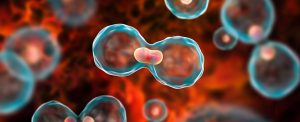48 4.1: Introduction to LIF
What is LIF?
LIF stands for Leukemia Inhibitory Factor. It is a pleiotropic cytokine part of the interleukin 6 family. LIF is a fascinating cytokine due to its involvement in many different pathways that are oftentimes contradicting. It is responsible for both the inhibition and stimulation of cell proliferation, differentiation and survival (Nicola and Babon, 1-13). This chapter will highlight the components of LIF and its role in cancer and tumor microenvironments.
LIF Signalling
LIF is responsible for many signalling pathways in embryonic stem cells, reproduction, bone remodelling, the neuromuscular system and cancer. LIF signals through a trimer of LIF bound to gp130 and LIFRβ (Fig. 1). The latter receptor is important for the Janus kinase-signal transducer and activator of transcription (JAK-STAT) signalling pathway (Onishi and Zandstra). LIF binds to both receptors with high affinity however the interaction with LIFRβ is 80 times closer compared to gp130. LIF receptors can be found in the liver, uterus, bone, and other major organs.

LIF and Cancer
Just as its name suggests, LIF is partly responsible for the inhibition of leukemia cells. However, LIF has displayed its function in inducing tumor progression and cell proliferations of certain myeloma, colon, breast, and prostate cancers. LIF regulates features of cancer stem cells which are cells responsible for tumor regeneration and treatment and/or drug resistance. Animal studies have shown that the overproduction of LIF in tumours has lasting effects in the surrounding tissue. Inhibition of LIF activity is a novel target in cancer immunotherapy and has the potential to produce a new treatment method.
The following chapters will discuss experimental techniques used in laboratory setting and how they can be applied to the study of LIF.

Test your knowledge:
